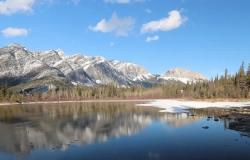Can Justin Trudeau Strike Canada’s Balancing Act?

Pledging a new commitment to climate action, the liberal government of Justin Trudeau will have to reconcile these initiatives with the economic boom generated by oil extraction. Canada faces tough decisions in responsibly managing its natural resources.
The recent giant wildfires in the Canadian provinces of Alberta and Saskatchewan have not just forced thousands of residents to leave their homes in the past weeks but also massively disrupted the country’s oil sands production. The events have once again fueled the discussion about resource development and environmental protection in Canada.
While Canada is unique among developed countries for its dependence on primary and extractive industries such as oil and gas, minerals and forestry, it faces a common problem in balancing economic development with environmental stewardship. Large developing countries such as China and India, along with developed countries with strong sub-national level climate policy such as the U.S. or Japan, face similar challenges when trying to balance economic and environmental concerns.
Natural resource exploitation can bring jobs and investment to rural areas that are often neglected. The revenues can help to support education, bolster law enforcement and build and maintain infrastructure. But the responsible management of these activities is vital in order to ensure a high quality of public health as well as environmental integrity.
For Canada particularly, reconciling dependence on primary industries, including energy and extractives as well as logging, with environmental commitments is a key challenge, as the Bertelsmann Stiftung’s Sustainable Governance Indicators (SGI) project confirms. SGI analyses and compares policymaking of all OECD and European Union countries. Thus, the path followed by Canada over the next four years of liberal government may offer insights into the new calculus of natural resource management in the post-Paris Climate Agreement world.
As the liberal government of Justin Trudeau swings the political needle away from the conservative government of Steven Harper, the new Prime Minister must reconcile campaign pledges with the economic benefits of energy industries. The Paris Agreement on Climate Change concluded at the end of 2015 promises a new global commitment to reigning in greenhouse gas emissions. Coupled with Trudeau’s promises to return Canada to a leadership role in climate protection, we are gaining a first glimpse of how this country will balance the two potentially opposing forces of natural resource exploitation and responsible environmental stewardship.
A prime example of this tension can be seen in the dynamic of Trudeau’s management of oil sands exploitation in Alberta where the need to safely get oil to refineries and export hubs contrasts pointedly with a new found desire to generate a national level climate change plan. The building blocks of a national climate strategy exist at the provincial level and the national government is looking to make a compromise on expanding oil sands infrastructure in exchange for additional provincial action on climate.
Energy industries buoy economy but pose environmental risks
Tax revenues, capital expenditure and jobs from energy and associated industries in Canada account for a significant level of economic activity. According to Natural Resources Canada, energy industries in Canada accounted for 13.4 percent of GDP while supporting 5 percent of employment. Canada has also received an average of $25.1 billion dollars in revenues from energy industries between 2008 and 2012 accounting for 11.9 percent of taxes paid during the same period.
Canada is the fifth largest crude oil producer and a net exporter of oil. However, the geographic location of the oil causes environmental and safety risks as well as political difficulty. The vast majority of the oil is located in the central province of Alberta with 97 percent being oil sands traditionally accessed through surface mining. Offshore production off the eastern shore of Newfoundland and Labrador contributes a notable amount of oil production as well, while reserves in the Arctic Ocean are currently uneconomical to develop.
The central location of main production centers in Alberta and other interior provinces mean that Canada depends on pipelines to transport raw materials to refining and export hubs located mainly in eastern and western provinces and in the United States. As the expansion of oil sands production has outpaced pipeline infrastructure development, rail transportation has become increasingly important to get products to markets.
This explosive growth of rail transport, which grew 172 percent between 2013 and 2014, draws concerns about the adequacy of rail infrastructure to handle dangerous substances and the capacity for local townships and rural areas to manage potential spills. When a train carrying crude oil derailed and exploded near Lac-Mégantic in 2013 Canada caught a tragic glimpse of the risks associated with increased rail transport of oil.
Sub-national climate action and promised environmental leadership
The heavy dependence of the Canadian economy on energy has been expressed in national level opposition to climate action. For many years the conservative Harper government maintained skepticism of global warming and has been unwilling to put forward effective greenhouse gas emission reduction strategies. The failure to regulate the booming oil and gas sector has contributed to the country’s overshooting of its voluntary commitments under the Copenhagen Accord. On top of this, significant cuts have been made to the Environment Canada’s climate change and clear-air program. The SGI project ranks Canada 36th of 41 countries on environmental policy, thus among the worst of all industrialized nations.
Despite opposition from the national government, Canada’s Second Biennial Report on Climate Change notes that climate action is being taken at the sub-national level to tackle global warming. British Columbia instituted a carbon tax in 2008, while Quebec has moved to integrate its cap and trade program with California, and Ontario has a comprehensive renewable energy and cap and trade policy as of 2015, among other provincial initiatives.
The existing framework of provincial climate initiatives offers the skeleton of a national plan, should Trudeau and his government pursue a policy of uniting the efforts. However, a key obstacle would be gaining the support of Alberta and other oil producing regions. Some commentators note that potential support for a climate action plan from the Alberta premier in exchange for a pipeline could enable Mr. Trudeau to gain an important concession from the dominant oil producing province.
The potential to strike such a common sense compromise in Canada could highlight options available to other countries and regions looking to accomplish both domestic and international goals related to climate change mitigation while tending to concerns about job creation and investment in rural areas. Daniel Bodansky and the Harvard Project on Climate Agreements have noted that subnational and regional climate policy can act as successful building blocks for national as well as international climate policy. Subnational policies for example, can be linked to national or international mitigation goals through national states formally recognizing province level programs and integrating their market systems into a national or international system. Alternatively, several subnational policies can be stitched together to form a national program used for compliance with international mitigation goals.
With an economy heavily dependent on primary production, in particular oil production, and the economic pain from falling oil prices setting in, the Canadian government has a difficult task ahead finding a balance between natural resource exploitation and environmental protection. While politically fraught in Canada, ensuring that existent pipelines are safe as well as potentially constructing new pipelines can help to avoid accidents and potentially pave the way for increased action on climate change.
Andrew Tanabe is an MPhil Candidate in Environmental Policy at the University of Cambridge and former legislative staff in the U.S. Senate. He writes for the Bertelsmann Stiftung’s SGI News.
Photo credit: davebloggs007 via Foter.com / CC BY


